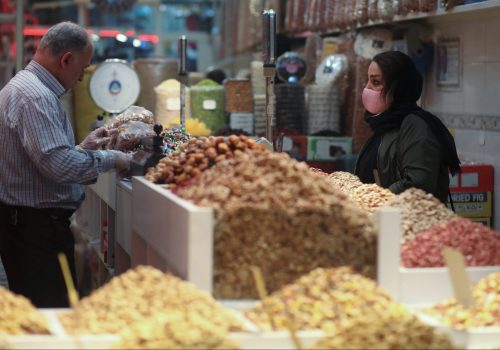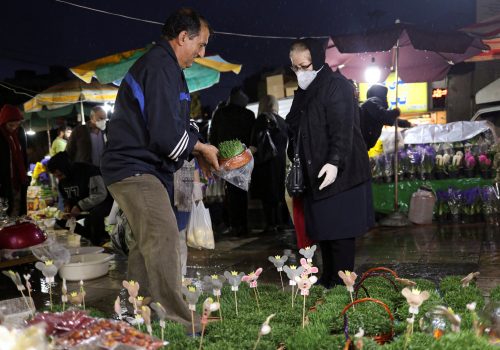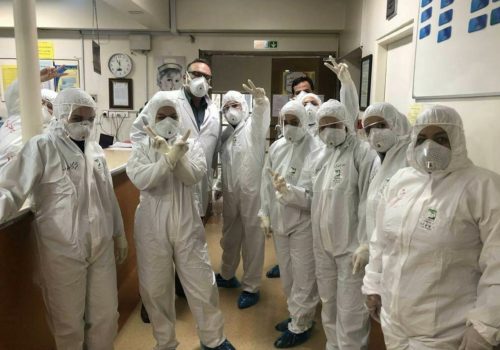Iranian New Year in the time of coronavirus
Just as the coronavirus was beginning to spread in Iran, my mother lost two of her dearest aunts to other ailments in mid-March. She and I visited one of them, who had experienced a stroke, in a Tehran hospital, where doctors and nurses were struggling to cope with the influx of coronavirus patients.
Everyone was panicking over COVID-19 and we had to wear masks and gloves to visit a hospital. When my mother’s aunt—my great-aunt—passed away, only a few people attended the funeral. There was no reception because all large social gatherings have been banned.
As we reached Nowruz, the Iranian New Year, a few days later—normally one of the happiest and most joyful times of the year in Iran—we could not visit family members or travel outside Tehran as we usually do. The best we could manage was a Haft Seen table in our home, seven items beginning with the Persian letter Seen to symbolize birth and renewal.
Many people, however, ignored the guidelines stated by the government to not travel during the holidays and travelled to the north of Iran, along the Caspian Sea, or other to cities. This has led the government to adopt stricter policies and regulations to stop people from travelling during the Nowruz holiday.
It has been about a month since the Iranian government disclosed the first individuals inside the country infected with COVID-19. There has been much criticism of officials for failing to quickly end flights to China and to quarantine those traveling from that country, the origin of the virus. There was also outrage that the government failed to postpone the February 21 parliamentary elections even though two days prior, the first cases in Qom were announced on state television.
Qom was belatedly put under quarantine and those outside seeking to go to the holy city are now barred. Fereshteh, who asked that only her first name be used, said she was desperate to see her family in Qom for both personal and urgent business matters, but no one would drive her there.
In Tehran, meanwhile, life has gone from normal to anything but.
People on the streets are wearing masks and gloves. The price of these protective items has skyrocketed amid shortages in the market.
At Shohadaye Tajrish public hospital, one of the first in Tehran to receive coronavirus patients, the staff seems in a state of panic. The neurology section of the hospital, where I visited my great-aunt, has been emptied of other patients and allocated entirely to coronavirus cases. The hospital has stopped allowing visitors for fear of spreading the disease.
Iranians who suffer from other chronic conditions are postponing treatment, among them, my uncle Mohsen, who suffers from eye problems due to high blood pressure. He has consulted, instead, with his doctor over the phone.
Others, such as Mojgan, a financial consultant, are obsessed with washing groceries including fruits with detergents and sanitizers. Mojgan has not left her home in the past 20 days and fears leaving the house even for a short time; many share this feeling of anxiety.
People waiting for elevators use sanitizers to spray the buttons and the elevator cabin. Neighbors avoid each other and maintain at least a one-meter distance.
The major Tehran cemetery, Behesht-e Zahra, tests for coronavirus for all those issued a death certificate. Victims of the disease are buried in certain sections of the cemetery with specific procedures and few mourners.
Iranians are especially concerned that the ratio of those who die from the virus to those who have been infected seems quite high. While the number of infected is much likely larger because of a lack of testing, as of April 1, the official number of those infected with coronavirus in Iran was 47,593 and the total number of deaths was 3,036—a death rate of nearly 6.5 percent. While Italy, Spain and France also have high percentages of fatalities, in the US, the total number of those infected was 190,909 and the total number of deaths 4,131. In Germany, the death rate was extremely low, 821 out of 74,508. While in China, which has had the highest number of persons infected with coronavirus so far, the number of infected was 81,554 whereas the total number of the deaths was 3,312—or a death rate of 4 percent.
The ratio points to the varying quality of medical treatment in different countries and the attention and care given to the patients. The high number of deaths in Iran compared to the number of those infected reflects poorly on the level of treatment.
Iran has historically had very good healthcare but like many countries, appears to have been overwhelmed by the number of coronavirus patients.
The lack of medical equipment, kits and medicine due to economic sanctions also plays a role. In many cases, the government has had difficulty accessing vital drugs and medical devices because of the difficulty of conducting international financial transactions. Iranians expect the United States and the international community to remove sanctions in a time of humanitarian crisis. Though the US insists that it has exempted medical needs from the sanctions, the banking system procedures in place impede such goods from reaching those in need. As the chair of the London-based NGO, Islamic Human Rights Commission recently put it, “We are part of the same global organism. And COVID-19 is continuing to spread through it.”
Tahereh Hadian-Jazy is a freelance writer in Iran. She holds a masters degree in modern Middle Eastern studies from Oxford University and has been accepted for a PhD at the University of St. Andrews.
Image: A man wears a protective face mask, amid fear of coronavirus disease, as he walks at Mellat park (Reuters)


